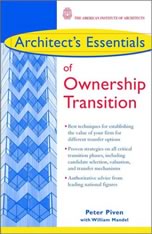
by Peter Piven, FAIA, with William Mandel, Esq.
Adapted with permission from Architect's
Essentials of Ownership Transition, Wiley & Sons, New York
City, 2002
 XYZ
Design, PC, is a 20-year-old, 20-person firm located in a midsize Midwest
city. Founders Frank Young and Frances Zimmer are 55 and 50 years old
respectively. Their regional practice serves health-care and related institutions
in the city and in the towns that fall within a 90-mile radius. The firm
gets the great majority of its commissions via repeat work and referrals
from satisfied clients and about 20 percent through proactive marketing.
XYZ
Design, PC, is a 20-year-old, 20-person firm located in a midsize Midwest
city. Founders Frank Young and Frances Zimmer are 55 and 50 years old
respectively. Their regional practice serves health-care and related institutions
in the city and in the towns that fall within a 90-mile radius. The firm
gets the great majority of its commissions via repeat work and referrals
from satisfied clients and about 20 percent through proactive marketing.
Frank would like to begin phasing down his active participation in the firm and retire in 10 years. He would like to start selling some of the ownership in the firm to key employees, but didn't know how to begin the process. Frank and Frances sough the advice of a management consultant experienced in ownership transition in professional design firms to discuss their intentions of bringing in new owners for their firm.
Frank and Frances identified Andrew and Barbara as good candidates for ownership, and provided factual information about the firm and its employees, and financial statement for the past few years. Andrew has been with them since the formation of the firm and is a loyal, hard-working project manager. Three years ago, Frank and Frances hired Barbara, who had been with a larger firm, with the understanding that if things worked out, Barbara would be offered ownership.
The management consultant selected to be part of XYZ Design's ownership transition team interviewed Frank and Frances to learn about their firm's management and operations, their objectives and concerns regarding ownership transfer, and their views about Andrew's and Barbara's strengths and weaknesses. The consultant then interviewed the candidates separately, both to evaluate them independently of the owners' impressions and to gauge their interest in becoming owners of the firm.
After analyzing the results of the meetings, the consultant advised the owners that Andrew is content to remain as a project manager and has no desire for ownership, despite his longevity with the firm. By contrast, Barbara has an entrepreneurial outlook and appears to have the necessary aptitude and desire to become an owner.
Making the deal work
Frank and Frances decide to offer Barbara a 10 percent ownership interest
in the firm, to be purchased from Frank, who is closer to retirement and
wants to begin selling down his ownership interest. Since Frank's goal
is to be fully retired in 10 years, and the value of the firm had been
established as $600,000, the cost of a 10 percent ownership interest in
the firm would be $60,000.
Contemplating that the price would be burdensome for Barbara, the consultant recommends establishing a deferred compensation plan for Frank, making the purchase more affordable for Barbara while at the same time rewarding Frank, as the founder, with a fair amount for his share of the firm.
The consultant recommends that the firm establish deferred compensation to Frank in the amount of $480,000. The result is that the value of the firms is reduced to $120,000. because the firm's liabilities have increased by the amount of the deferred compensation. With the value of the firm reduced to $120,000 a 10 percent ownership will cost Barbara $12,000.
Barbara will pay the seller of the stock (either Frank or the firm) $12,000 in exchange for a 10 percent ownership interest in the firm. At the same time, the firm will enter into an agreement with Frank to pay him $480,000 as deferred compensation over an agreed-upon period of years, beginning either now or in the future when he begins to withdraw from daily involvement in the firm.
The deferred compensation will be ordinary income to Frank and therefore will be taxed at an ordinary income tax rate. Frank and the firm enter into a deferred compensation agreement under which Frank will receive the deferred compensation as ordinary income, paid through the firm's regular payroll over a period of five years. (Because it will be taxed at an ordinary income-tax rate, which is greater than the capital gains rate, the firm considers increasing the deferred compensation amount by 20 percent to compensate for the tax difference.) Deferred compensation payments will begin five years after Barbara's purchase, when Frank will begin to reduce his time spent on the firm's business.
Copyright 2002 The American Institute of Architects. All rights reserved.
![]()
|
Architect's Essentials of Ownership Transition describes ownership transition options, candidate selection, firm valuation, ownership transfer mechanisms, designing a transition program, getting the program started, documentation, choosing the form of the entity, developing leadership, and preparing for future transition. Author Peter Piven, FAIA, with William Mandel, Esq., bring their scores of cumulative years' setting up design firms and making them work to create this readable, practical guide as part of the Wiley & Sons series, created in partnership with the AIA, Architect's Essentials. Each book is $32 AIA members/$35 retail (plus $6 shipping per order). To order from the AIA Bookstore: phone: 800-242-3837 option #4; fax 202-626-7519; or send an email.
|
|
